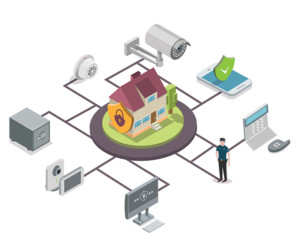
Why do people break in and steal? It’s an old question, and for centuries, societies seemed to deal more with punishing thieves than preventing them. For instance, during medieval times, thieves could have their hands or ears cut off — if they weren’t hung outright. Today, though, most business managers and property owners simply prefer to avoid theft altogether. But how do you focus on theft prevention?
Recent studies have provided an unsurprising answer: High-tech security systems help. For example, research published by The University of North Carolina at Charlotte Department of Criminal Justice & Criminology found that roughly two-thirds of burglars would immediately avoid a property due to the presence of an alarm. This perimeter protection guide will provide you with important points regarding the first thing your security system should seek to safeguard — namely your property’s perimeter.
Perimeter Risk Assessment
When considering the installation of or an upgrade to a security system, the security professional you employ should always begin with a perimeter risk assessment. Why? Quite simply, the data supports the idea that reliable boundary security stymies many types of crimes. A 2013 study published in Justice Quarterly found that “housing units in gated communities experience less burglary than their non-gated counterparts.” Additionally, the Journal of Research in Crime and Delinquency found that thieves’ choice of targets is at least partially due to “the proportion of easily accessible targets” (emphasis added).
What does a perimeter risk assessment entail? Its first goal involves you and your organization’s values and, more specifically, determining what exactly needs protecting. When asked this, many stakeholders find themselves instinctively answering, “Everything!” However, no expert can completely safeguard against every eventuality, and so it’s always smart to analyze the situation and set priorities.
Next, a perimeter risk assessment should inspect the property and any extant security measures in their current state. This step involves examining the site to ensure that its boundary can’t be easily breached. For instance, any natural topography should not allow authorized parties to easily surmount a barrier or to hide vehicles that might facilitate theft.
After this step, the assessment ought to address what specific alterations could enhance the security of the site. Additionally, it should include a cost/benefit analysis that plots the economic impact of any upgrades.
Perimeter Security Solutions Available
Perimeter protection products come in multiple variations and configurations. Indeed, when most clients consider perimeter protection equipment, they think of double-row fencing or high-security palisade fencing or even electric fencing systems. These are all viable and even important options for many businesses and multifamily communities. However, associating a perimeter protection system solely with fencing overlooks several important elements.
Experts generally don’t think of perimeter protection services as dealing solely with the outlying boundary demarcating the furthermost point of a property. Rather, perimeter protection involves layers or stages of protection. Some pundits prefer to compare it to the ways in which medieval castles had increasing numbers of obstacles to overcome on the way to the keep. That’s not a bad contrast, and that medieval model still holds somewhat true today.
Yes, fences at an area’s actual perimeter are an important part of perimeter security. But so are gate systems that control which vehicles gain entry and license plate recognition systems which keep a legally actionable record of who attempts to drive in. Manned and virtual guard stations play an important role in maintaining the boundary around your property. At the actual walls of your property, old standbys such as CCTV cameras or newer technology like an access control system become the innermost parts of a perimeter protection system.
Perimeter Security System Selection and Situational Requirements Analysis
Selecting a perimeter security system isn’t as easy as looking down a list of the latest security developments and picking the newest model of a specific item. Any purchase, installation, or management decision should first involve a situational requirements analysis.
Simply put, a situational requirements analysis considers your current context, your stated needs and goals, and the required capital outlay and updated staffing needs. It’s closely tied with perimeter risk assessment and traditional SWOT (i.e., Strengths, Weaknesses, Opportunities and Threats) analysis. Any good situational requirements analysis needs a clear application of the stated values laid out in the perimeter risk assessment.
For example, suppose that you’re managing an apartment complex that’s located next to a major highway or interstate and your primary concern is the safety of your residents. Additionally, you currently have a manned security post at the main entrance, and the agency-provided security guards have drawn efficiency-related complaints. A situational requirements analysis might recommend that you install a gate-access system and a cloud-based virtual guard kiosk.
Allow us to stress that such analyses depend heavily on your specific situation. A warehouse stuck in commercial lockdown due to a pandemic or a strip mall that depends on foot traffic will have very different requirements and very different professional recommendations.
Importance of Systems Integration
Perimeter intruder detection systems and run-of-the-mill security systems have at least one thing in common: It is utterly essential that all of their components integrate into a seamless whole. For example, some companies recommend fence-mounted motion sensors to safeguard an area’s perimeter. Unfortunately, strong winds and small animals tend to trigger such sensors, leading to false alarms. Sometimes, though, these sensors fail to trigger at all, which is far more serious when dealing with an intrusion situation. In other words, these sensors often don’t integrate well with the remainder of the system.
The need for property perimeter protection system integration — for the system to work as a unified whole — is part of the reason why we rarely recommend that clients update their systems in a piecemeal fashion. While that may seem like a monetarily wise choice, it can often have a much greater long-term “cost,” one measured in very real economic losses and (in some horrible cases) human life.
If you need a trusted security partner to help implement a perimeter protection system, look no further than AT&I Systems. With multiple decades of experience in helping commercial clients implement the most effective security solutions for their situations. Contact or call us today at (866) 436-3516 to see how we can help!


















